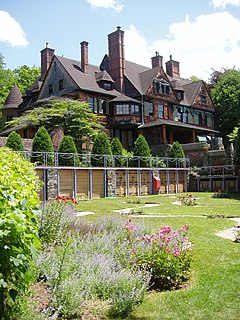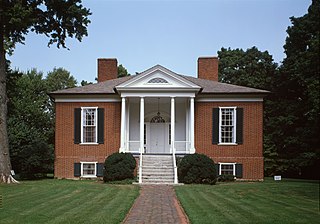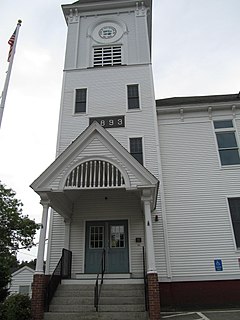
Naumkeag is the former country estate of noted New York City lawyer Joseph Hodges Choate and Caroline Dutcher Sterling Choate, located at 5 Prospect Hill Road, Stockbridge, Massachusetts. The estate's centerpiece is a 44-room, Shingle Style country house designed principally by Stanford White of McKim, Mead & White, and constructed in 1885 and 1886.

Farmington, an 18-acre (7.3 ha) historic site in Louisville, Kentucky, was once the center of a hemp plantation owned by John and Lucy Speed. The 14-room, Federal-style brick plantation house was possibly based on a design by Thomas Jefferson and has several Jeffersonian architectural features. As many as 64 African Americans were enslaved by the Speed family at Farmington.

The Harding Home is a historic house museum at 380 Mount Vernon Avenue in Marion, Ohio. It was the residence of Warren G. Harding, twenty-ninth president of the United States. Harding and his future wife, Florence, designed the Queen Anne Style house in 1890, a year before their marriage. They were married there and lived there for 30 years before his election to the presidency.

The Morris–Butler House is a Second Empire-style house built about 1864 in the Old Northside Historic District of Indianapolis, Indiana. Restored as a museum home by Indiana Landmarks between 1964 and 1969, the American Civil War-era residence was the non-profit organization's first preservation project. Restoration work retained some of its original architectural features, and the home was furnished in Victorian and Post-Victorian styles. Its use was changed to a venue for Indiana Landmarks programs, special events, and private rentals following a refurbishment in 2013. Regular daily tours of the property have been discontinued.

Pettit Memorial Chapel or simply, Pettit Chapel, is one of the few chapels designed by architect Frank Lloyd Wright. The Pettit Chapel is located in the Belvidere Cemetery in Belvidere, Illinois, United States, which is in Boone County. It was listed on the U.S. National Register of Historic Places on December 1, 1978. The chapel is an early example of Frank Lloyd Wright's famed Prairie style. It is one of only two structures meant for a cemetery setting that Wright ever created.

The Aaron G. Cloud House, now the McCoy Memorial Library, is a historic house in McLeansboro, Illinois, which is now used as the city's public library. The house was built in 1884 for Aaron G. Cloud, the founder of the Cloud State Bank; it has served as a library since 1922. The Reid Brothers, an architectural firm from Evansville, Indiana, designed the home. The red brick house features a central tower with a pyramidal roof atop the front entrance, a semicircular bay on the front facade, and an entrance porch spanning three bays of the building. The house includes Eastlake Style ornamentation throughout its design. The house includes nine interior fireplaces; the four fireplaces on the first floor are surrounded by decorative wood and tiles.

The Asa Packer Mansion is a historic house museum on Packer Road in Jim Thorpe, Pennsylvania, United States. Completed in 1861, it was the home of Asa Packer (1805–1879), a coal and railroad magnate, philanthropist, and founder of Lehigh University. Asa Packer was also a major contributor in the Lehigh Valley Railroad system. The mansion is one of the best preserved Italianate Villa homes in the United States, with original Victorian furnishings and finishes. It was designated a National Historic Landmark in 1985.

Dr. Susan LaFlesche Picotte Memorial Hospital, also known as Walthill Hospital or Dr. Susan Picotte Memorial Hospital, is a former hospital building at 505 Matthewson Street in Walthill, Nebraska, on the Omaha Indian Reservation. The hospital was developed by Dr. Susan LaFlesche Picotte (1865–1915), the first female Native American medical doctor. Built with money raised by Picotte from various sources, it was the first hospital for any Indian reservation not funded by government money. It served the community as a hospital until the 1940s, and has had a variety of other uses since. It was declared a National Historic Landmark in 1993.

The Glover House, also known as the Budd House, is a historic house at 50 Main Street in Newtown, Connecticut. Built in 1869, it is a good local example of Second Empire architecture, and is further notable for the long tenancy of a single prominent local family. It was listed on the National Register of Historic Places in 1982.

The Ford–Bacon House is located at 45 Vinewood in Wyandotte, Michigan. It was designated a Michigan State Historic Site in 1987 and listed on the National Register of Historic Places in 1997. It is now used as the Bacon Memorial District Library.

The Flora Stone Mather College District is a 3.6-acre (1.5 ha) historic district in Cleveland, Ohio, United States. It includes five contributing buildings.

The Post House is a historic house located at 1516 State St. in Alton, Illinois, United States. William Post, a steamboat captain who later became mayor of Alton, built the house in 1837–38. The brick and limestone house is designed in the Greek Revival style. The house's front facade features four Doric columns topped by an entablature and a pedimented gable end. The front porch of the house wraps around both sides, each of which has an additional column and a pilaster. The cornice and front pediment are both dentillated. James Patterson, owner of the Illinois Iron Works, purchased the house in 1854; Patterson may have added the iron porch railing.

The John C. Anderson House is a historic house located at 920 W. Breckenridge St. in Carlinville, Illinois. The house's first floor was built in 1883, while its second floor was added in 1892. The first floor has an Italianate design featuring tall, narrow windows, an asymmetrical porch with paired columns, paired brackets, and a dentillated cornice. The second floor is designed in the Queen Anne style and includes a square tower with stick style framework, a multi-component roof with gabled dormers, and a stained glass window with a decorative wooden frame. Local banker C.H.C. Anderson built the house for his son John C. Anderson as a wedding gift; John and his wife Lucy lived in the house until their deaths in the 1930s.

Rollinsford Town Hall is located at 667 Main Street in Rollinsford, New Hampshire. The two-story wood-frame building was designed by New Hampshire architect Alvah T. Ramsdell, and built in 1893 to house a variety of municipal services, and an auditorium. The building, still housing municipal offices, was listed on the National Register of Historic Places in 1999.

The Karsner-Carroll House is a historic residence in Florence, Alabama. The lot on which the house sits was purchased in 1818 by James Gadsden; the lot to the west was purchased by his commanding officer in the War of 1812, Andrew Jackson. The house was built sometime before 1830 by B. F. Karsner. In 1902 it was purchased by Dr. George W. Carroll, whose daughter Bertha later lived in the house with her husband Oscar Y. Kennedy.
Oakmont, also known as the William Albion Dunn House, is a historic home located at Greenville, Pitt County, North Carolina. It was designed by the architectural firm Benton & Benton and built in 1930. It is a two-story, five bay Colonial Revival frame dwelling with projecting frame wings, a screened porch and porte cochere and an open porch and rear sun room. Also on the property are the contributing garage, playhouse, and house site.
The Drouillard House is a historic house at Cumberland Furnace, Tennessee. Built in 1868–1870 in the vicinity of Cumberland Furnace, the three-story house was a summer residence for Nashville socialite Mary Florence Kirkman and her husband Captain James Pierre Drouillard. It has been listed on the National Register of Historic Places since December 27, 1977.
Lucas Pfeiffenberger was an architect. He won an award at the World’s Columbian Exposition in 1893 for his design of Garfield School in Alton, Illinois.
The Howard and Lucy Linn House is a historic house at 555 Shoreacres Drive in Lake Bluff, Illinois. The house was built in 1927 for Lucy Linn, the founder or president of multiple Chicago social organizations and a member of the prominent McCormick family, and her husband Howard, a businessman and aviator. The couple was typical of the wealthy, socially prominent people who built estates in Lake Bluff and neighboring Lake Forest. Architect Walter S. Frazier of the firm Frazier & Raftery designed the house in the French Renaissance Revival style, a choice inspired by Howard's service in France in World War I. The house has an asymmetrical plan with a stucco exterior, a loggia at the front entrance, a central courtyard, and several porches.

















